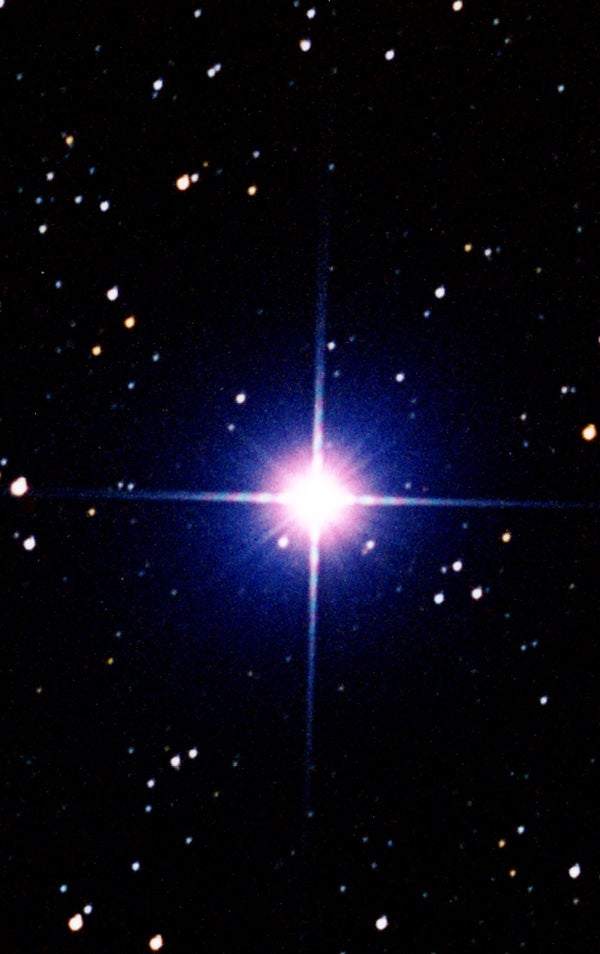While Altair and Vega are 17 and 25 light-years away, respectively, a gap of more than 1,400 light-years separates us from Deneb. This star is, in fact, one of the most luminous in the galaxy — a blue-white supergiant with the light output of more than 50,000 Suns! Were this stellar colossus as near as Altair, it would be a dazzling magnitude –8.4 star easily visible during daylight hours and able to cast distinct shadows at night.
The vast rift separating us from Deneb denies us such a visual spectacle, but it also protects us from the effects of this star’s ultimate demise. Like all supergiants, Deneb is destined for a sudden and violent end as a type II supernova — the rapid collapse and violent explosion of a massive star. The event could possibly occur within the next few million years — a cosmic blink of the eye. At Altair’s distance, a Deneb supernova would be nearly 1,000 times brighter than the Full Moon and prove catastrophic to life on Earth. The gamma radiation released would seriously deplete our atmosphere’s protective ozone layer, allowing life-threatening levels of solar and cosmic radiation to reach the ground. We’re fortunate to be able to admire this magnificent star from a safe distance.
Deneb, the Alpha (α) star in Cygnus, provides the constellation’s brawn; Albireo (Beta [β] Cygni) is the beauty. Many regard Albireo as one of the heaven’s loveliest double stars, and with good reason. Its topaz-yellow and sapphire-blue tints are remarkable, especially when compared to Deneb’s diamond-like sparkle. The color contrast is especially amazing to anyone who assumes all stars are white. For this reason, Albireo should be on the observing list of any astronomy club hosting a public star party now and throughout autumn.
Albireo is particularly popular with owners of small-aperture telescopes. Not only is this pair easily resolved with magnifications as low as 20x to 30x (a spacious 34″ separate its magnitude 3.1 and 5.1 components), but its colors also appear much more vivid when viewed with 2- to 4-inch scopes than with larger instruments.
The beauty of this activity is that virtually anyone can do it, as long as you can locate Cygnus in the night sky. No equipment other than eyes, a red flashlight, and a set of magnitude charts (obtainable off the Great World Wide Star Count website) is necessary. The process isn’t time-consuming either. It takes 10 to 15 minutes to make an observation, and another 10 to forward the data. The activity is so simple, you may want to make multiple observations by extending your Cygnus star counts to other communities near your home.
The Great World Wide Star Count is a meaningful activity for astronomy clubs. Club officers should encourage their members to participate, especially because light pollution is a menace all amateur astronomers must deal with. Teachers, as well as individuals involved with secondary-school outreach programs, will appreciate the opportunity to engage their students in scientific data collection and analysis.
Perhaps you live in the Southern Hemisphere, where Cygnus barely, if at all, rises above the northern horizon. No problem! Remember, this is a global effort. Your light-pollution litmus for the star count is the constellation Sagittarius.
Last year, the Great World Wide Star Count collected nearly 4,500 observations. NESTA graphically portrays the results on a world map set up on the Great World Wide Star Count website. Refer to the map to see what regions of the world were covered. If you live in an area where no one filed a report, make a star count to help fill in the gaps. Let’s all do our part to document the spread of light pollution. For more information, log on to www.windows2universe.org/citizen_science/starcount.
Questions, comments, or suggestions? E-mail me at gchaple@hotmail.com. Next month: Happy 100th, AAVSO! Clear skies!












